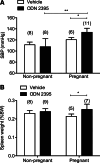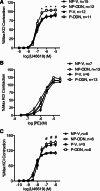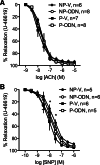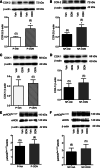Exposure to stimulatory CpG oligonucleotides during gestation induces maternal hypertension and excess vasoconstriction in pregnant rats
- PMID: 26873968
- PMCID: PMC11961075
- DOI: 10.1152/ajpheart.00834.2015
Exposure to stimulatory CpG oligonucleotides during gestation induces maternal hypertension and excess vasoconstriction in pregnant rats
Abstract
Bacterial infections increase risk for pregnancy complications, such as preeclampsia and preterm birth. Unmethylated CpG DNA sequences are present in bacterial DNA and have immunostimulatory effects. Maternal exposure to CpG DNA induces fetal demise and craniofacial malformations; however, the effects of CpG DNA on maternal cardiovascular health have not been examined. We tested the hypothesis that exposure to synthetic CpG oligonucleotides (ODNs) during gestation would increase blood pressure and cause vascular dysfunction in pregnant rats. Pregnant and nonpregnant female rats were treated with CpG ODN (ODN 2395) or saline (Veh) starting on gestational day 14or corresponding day for the nonpregnant groups. Exposure to CpG ODN increased systolic blood pressure in pregnant (Veh: 121 ± 2 mmHg vs. ODN 2395: 134 ± 2 mmHg,P< 0.05) but not in nonpregnant rats (Veh: 111 ± 2 mmHg vs. ODN 2395: 108 ± 5 mmHg,P> 0.05). Mesenteric resistance arteries from pregnant CpG ODN-treated rats had increased contractile responses to U46619 [thromboxane A2(TxA2) mimetic] compared with arteries from vehicle-treated rats [Emax(%KCl), Veh: 87 ± 4 vs. ODN 2395: 104 ± 4,P< 0.05]. Nitric oxide synthase (NOS) inhibition increased contractile responses to U46619, and CpG ODN treatment abolished this effect in arteries from pregnant ODN 2395-treated rats. CpG ODN potentiated the involvement of cyclooxygenase (COX) to U46619-induced contractions. In conclusion, exposure to CpG ODN during gestation induces maternal hypertension, augments resistance artery contraction, increases the involvement of COX-dependent mechanisms and reduces the contribution of NOS-dependent mechanisms to TxA2-induced contractions in mesenteric resistance arteries.
Keywords: Toll-like receptor 9; cyclooxygenase; hypertension; preeclampsia; vascular function.
Copyright © 2016 the American Physiological Society.
Figures









References
-
- Arechavaleta-Velasco F, Gomez L, Ma Y, Zhao J, McGrath CM, Sammel MD, Nelson DB, Parry S. Adverse reproductive outcomes in urban women with adeno-associated virus-2 infections in early pregnancy. Hum Reprod 23: 29–36, 2008. - PubMed
-
- Chatterjee P, Chiasson VL, Kopriva SE, Young KJ, Chatterjee V, Jones KA, Mitchell BM. Interleukin 10 deficiency exacerbates toll-like receptor 3-induced preeclampsia-like symptoms in mice. Hypertension 58: 489–496, 2011. - PubMed
Publication types
MeSH terms
Substances
Grants and funding
LinkOut - more resources
Full Text Sources
Other Literature Sources
Medical

